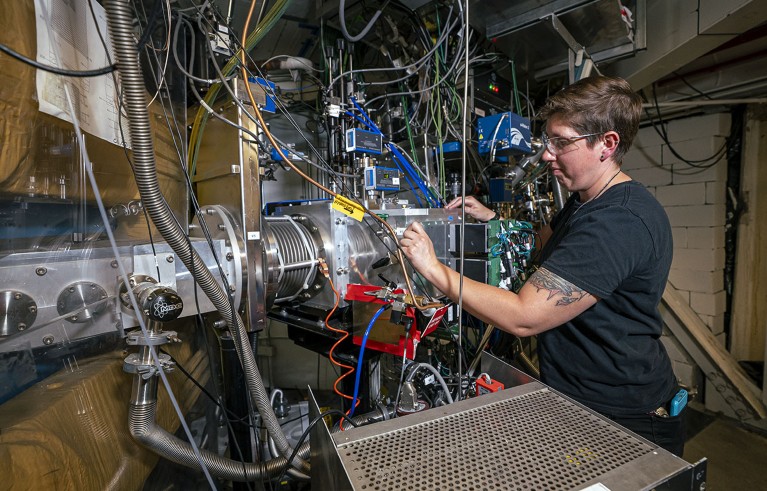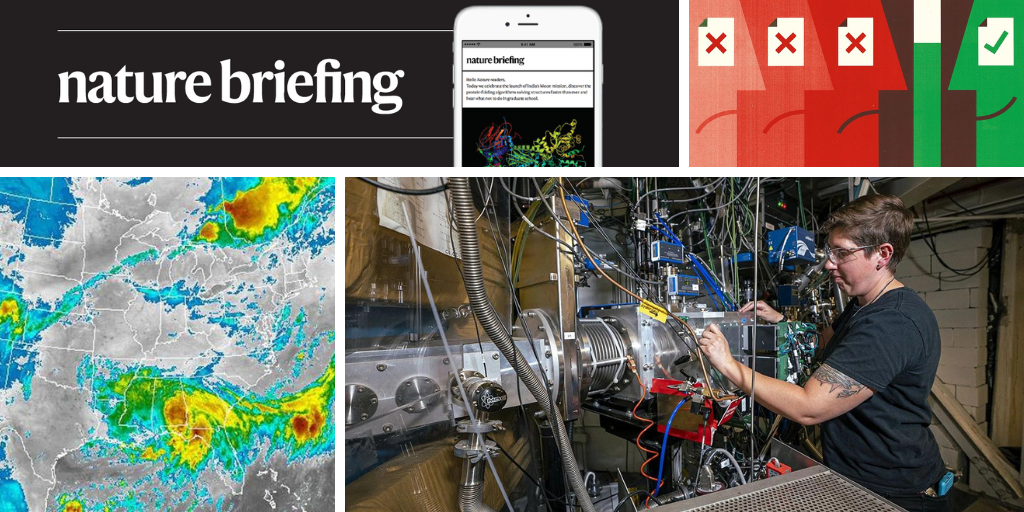Hello Nature readers, would you like to get this Briefing in your inbox free every day? Sign up here.

Jacklyn Gates, leader of the Heavy Element Group at Lawrence Berkeley National Laboratory in California, is heading up the effort to create element 120.Credit: Marilyn Sargent, LBNL. © The Regents of the University of California, Lawrence Berkeley National Laboratory
Researchers have demonstrated a new way to make superheavy elements, opening the door to creating the heaviest element ever and adding another row to the periodic table. Scientists used a beam of titanium to make a known superheavy element, livermorium — element 116. If they’re able to make elements 119 and 120, as planned after an equipment upgrade, they will be the first documented from the eighth ‘period’. In this row, scientists expect to find atoms with so-far unseen electron configurations.
Reference: arXiv preprint
A machine-learning tool slashes the computing power needed to predict future climate and could help us be better prepared for extreme weather events. The tool, co-developed by Google, combines AI machine learning with conventional weather forecasting. It opens the door for faster forecasting that is less energy-intensive than existing tools, and better at predicting long-term forecasts than purely AI-based approaches. “The issue with pure machine-learning approaches is that you’re only ever training it on data it’s already seen,” says AI researcher Scott Hosking. “The climate is continuously changing, we’re going into the unknown, so our machine-learning models have to extrapolate into that unknown future.”
Sunday was the hottest day in recent history — until Monday. The daily global average temperature was 17.15°C on 22 July, exceeding the previous record of 17.09°C, set on 21 July. “What is truly staggering is how large the difference is between the temperature of the last 13 months and the previous temperature records,” says Carlo Buontempo, director of the European Commission’s Copernicus Climate Change Service (C3S). “We are now in truly uncharted territory.”
Explore the data in near-real-time in the C3S’s Climate Pulse application.
Features & opinion
Academia has a well-known ‘file-drawer problem’: findings with null or negative results — those that fail to find a relationship between variables or groups, or that go against the preconceived hypothesis — gather dust in favour of studies with positive or significant findings. Over time, this bias in publications distorts the scientific record, warps incentives and wastes time and money on duplicate research. But changes have started to materialize across the publishing industry, as preprint servers proliferate and publishers adopt new manuscript formats, launch journals dedicated to null results and call for special issues.
A brain haemorrhage late in pregnancy upended bioengineer Parisa Hosseinzadeh’s life — and her tenure clock. Thanks to supportive physicians, family and colleagues, she’s restarting her academic career.
“At a practical level, the era of close and unfettered collaborations between US and Chinese scientists and technologists has come to an end,” observes Yasheng Huang, a global-economics and management researcher. For example, toxic geopolitics is eating away at frameworks such as the US–China Science and Technology Cooperation Agreement. Scientists must help to craft a pragmatic case for continuing bilateral collaborations in certain areas, he argues. “Scientists should not be mere bystanders,” writes Huang. “US–China relations are too important to be left entirely to the politicians.”
I’ll be logging off in London for the next couple of weeks and re-connecting to the Wood Wide Web in the forests of British Columbia. You’ll be in the capable hands of Briefing associate editor Katrina Krämer for the next couple of days, and then we’ll take a break and be next in your inbox on Monday, 12 August.
This week is Katrina’s last here at Briefing towers. Regular readers will know the enormous contribution she’s made to this newsletter over the past two years. I hope you’ll join me in thanking Kat and wishing her all the best in her next adventure!
Thanks for reading,
Flora Graham, senior editor, Nature Briefing
With contributions by Katharine Sanderson
Want more? Sign up to our other free Nature Briefing newsletters:
• Nature Briefing: Microbiology — the most abundant living entities on our planet — microorganisms — and the role they play in health, the environment and food systems.
• Nature Briefing: Anthropocene — climate change, biodiversity, sustainability and geoengineering
• Nature Briefing: AI & Robotics — 100% written by humans, of course
• Nature Briefing: Cancer — a weekly newsletter written with cancer researchers in mind
• Nature Briefing: Translational Research — covers biotechnology, drug discovery and pharma



More News
The Amazon’s gargantuan gardeners: manatees
Publisher Correction: Single-crystalline metal-oxide dielectrics for top-gate 2D transistors – Nature
The baseless stat that could be harming Indigenous conservation efforts